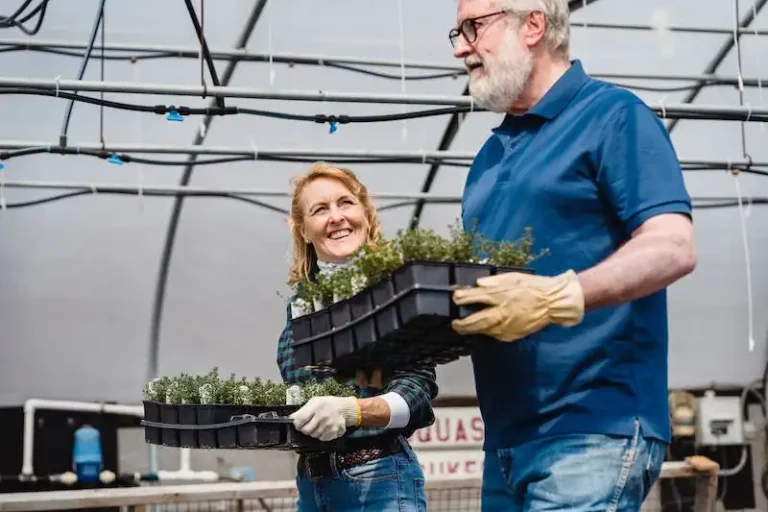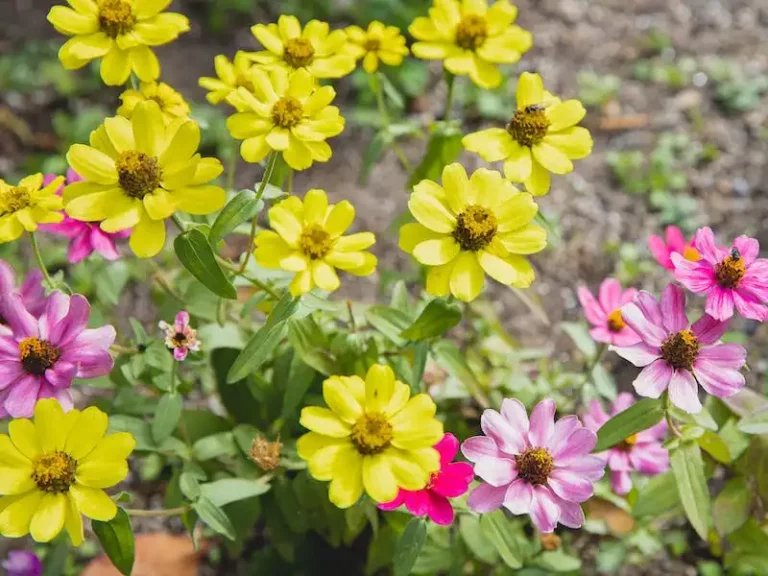Borage, also known as Borago officinalis, is a flowering plant that provides numerous health benefits. It is often grown in vegetable gardens because of its ability to attract bees and deter pests. Borage is a self-seeding plant that easily grows in all soil conditions and is well-suited to organic gardening.
When planting borage, it is important to choose a suitable location that receives full sunlight. Borage can grow in a variety of soil types, but it thrives in well-drained soils. Before sowing the seeds, it is recommended to prepare the soil by removing weeds and adding compost or organic fertilizers for optimal growth.
Borage is an excellent companion plant for many vegetables, including tomatoes, squash, and cucumbers. Its cucumber-flavored leaves can enhance the flavor of these plants. In addition, borage attracts beneficial insects such as bees and wasps, which help to pollinate the garden and control pests.
After sowing the borage seeds, it is important to water the plants regularly to ensure proper growth. Borage requires moderate watering and should be watered deeply, especially during dry periods. Applying mulch around the plants can help retain moisture and suppress weeds.
As the borage plants grow, it is advisable to thin them out to provide enough space for healthier growth. This can be done by removing the weaker seedlings as they emerge. Borage often grows up to 2 feet tall and can spread quite vigorously, so proper spacing is essential.
Pruning borage is not necessary unless it becomes overcrowded or starts encroaching on other plants. The flowers of the borage plant are highly attractive to bees, resulting in increased pollination. The flowers can be consumed and used as a garnish in salads or drinks. Additionally, the seeds of the plant are rich in gamma-linolenic acid, which provides various health benefits.
In conclusion, planting borage in your vegetable garden can be a wise decision due to its numerous benefits. With just a little care and attention, borage can thrive and provide you with free, flowering plants that attract bees and deter pests. So why not try planting borage in your garden and enjoy the cucumber-flavored leaves and beautiful blossoms it has to offer?
Borage Herb: How To Grow Borage
Borage, also known as Borago officinalis, is a lovely herb that is easy to grow and provides many benefits in the garden. Its beautiful blue star-shaped flowers are not only a sight to behold, but the plant itself has a long history of use in culinary and medicinal applications. In this guide, we will provide you with all the info you need to successfully grow borage in your garden.
Planting Borage:
Borage can be started from seeds, which should be sown directly into the ground. The best time to begin sowing is in early spring, but you can also sow later in the season depending on your location. Borage can tolerate a wide range of soils, although it prefers well-draining soil that has been enriched with compost or organic matter. Find a sunny location where borage can receive at least six hours of sunlight per day.
Companion Plants and Sowing:
Borage is an excellent companion plant for many vegetables and herbs. It is particularly beneficial when planted near tomatoes, as it helps deter tomato hornworms and attracts beneficial insects like bees. Borage is also known to improve the flavor of strawberries and squash when planted nearby. It is important to keep in mind that borage can be invasive, so it is recommended to plant it in between other crops or in containers to prevent it from taking over your garden.
Growing Borage:
Once the seeds are sown, borage will begin to emerge within a week or two. The plant grows relatively quickly and usually reaches a height of about 2-3 feet. Borage is drought-tolerant, but it should still be watered regularly, especially during dry periods. Avoid overwatering, as borage does not tolerate wet feet. Mulch around the plant to help retain moisture and suppress weed growth.
Harvesting Borage:
Borage is ready for harvest when the plant is in full bloom. Harvest the leaves and flowers when they are still young and tender for the best flavor. Borage leaves can be added to salads, soups, and other dishes to add a cucumber-like taste. The flowers can be used as a garnish in drinks or salads. To prolong the harvest, deadhead the plant regularly to encourage new growth.
Self-Sowing and Pruning:
Borage is known to self-sow, meaning that it will drop seeds that will sprout on their own in the following seasons. If you wish to control its spread, it is recommended to prune the plant after it finishes flowering. Cut the plant back to ground level, but be careful not to remove any emerging seedlings or next year’s growth. The pruning process will prevent borage from becoming invasive and taking over your garden.
In conclusion, borage is a versatile and beneficial herb to grow in your garden. It attracts bees, improves flavor in companion plants, and is easy to care for. As long as you provide it with the right growing conditions and follow the instructions mentioned above, you can enjoy a bountiful harvest of this quick-growing, highly-flavored herb.
Borage Plant Info
Borage (Borago officinalis) is a popular herb that originates from the Boraginaceae family. It is best known for its beautiful blue flowers and high self-sowing capabilities, making it an easy plant to grow in many gardens. Borage is suitable for a wide range of soils and thrives in full sun.
When planting borage, it is important to sow the seeds directly in the garden, as it does not transplant well. Borage can be sown as early as the last frost date, and it prefers organic, well-draining soils. It is recommended to add compost or organic matter to the soil before planting to ensure a nutrient-rich environment.
Borage is a great companion plant for many vegetables and fruit trees. Its presence can attract beneficial insects such as bees and butterflies, which helps with pollination. Additionally, borage is known to repel pests like aphids when planted near susceptible plants. The flowers and foliage of borage are also edible and can be used to flavor dishes or make herbal medicines.
One of the unique characteristics of borage is its ability to self-sow. Once the flowers bloom and produce seeds, they will scatter and grow new plants within the garden. This can be both a blessing and a curse, as borage can quickly populate an area if not managed properly. To prevent it from becoming a weed, try harvesting the plants before they go to seed or remove any unwanted seedlings.
While borage is generally a low-maintenance plant, there are a few potential problems you may encounter. Borage can be susceptible to some diseases and pests, such as powdery mildew and bugloss aphids. If you notice any signs of infection, it is best to remove the infected plants to prevent the spread to other nearby plants.
In conclusion, borage is a versatile herb that is easy to grow and has many uses in the kitchen, as well as for medicinal purposes. Its beautiful blue flowers and attractive foliage make it a welcomed addition to any garden. Whether you are a seasoned gardener or a beginner, borage is definitely a plant worth considering.
- Borage originates from the Boraginaceae family.
- It is best known for its beautiful blue flowers.
- Borage is a self-sowing plant.
- It thrives in full sun and is suitable for a wide range of soils.
- Borage should be sown directly in the garden as it does not transplant well.
- Adding compost or organic matter to the soil before planting is recommended.
- Borage is a great companion plant and can attract beneficial insects.
- It can repel pests like aphids when planted near susceptible plants.
- The flowers and foliage of borage are edible and can be used for flavoring and medicinal purposes.
- Borage has the ability to self-sow and can quickly populate an area if not managed properly.
- It can be susceptible to diseases and pests such as powdery mildew and bugloss aphids.
- Harvesting the plants before they go to seed can help prevent it from becoming a weed.
Growing Borage
Borage, also known as Borago officinalis, is a beautiful and beneficial herb to have in your garden. It is commonly grown for both its medicinal uses and its vibrant blue flowers. If you are new to growing borage, here are some tips to help you get started.
Sowing
When planting borage, the best location is in full sun. Borage is quite tolerant and can also handle some shade, but it will thrive in sunny conditions. Borage grows well in most soils, but it prefers well-drained organic soils. Sow the seeds directly in the ground after the last frost has passed.
Companion Plants
Borage is a fantastic companion plant and can be planted alongside a variety of vegetables and herbs. It is particularly beneficial to squash plants, as it deters pests and attracts bees for pollination. Some common companion plants for borage include tomatoes, strawberries, and cucumbers.
Growth and Harvesting
Borage is a fast-growing plant and can reach a mature height of up to 2 feet. It has a taproot, so be sure to plant it where it will have enough space to grow downwards. Borage has a long flowering period, typically blooming from late spring to early autumn. The flowers are a sight to behold, attracting bees and other pollinators to your garden.
When harvesting borage, it is best to do so before the flowers fully open. This is when the flavor is at its peak. The leaves and flowers can be used fresh or dried for later use.
Propagation
Borage is a self-seeding plant, which means it will easily reseed itself in the garden. If you let the plant go to seed, it will come back year after year. If you don’t want it to spread, be sure to deadhead the flowers before they form seeds.
Pests and Troubleshooting
Borage is generally pest-resistant, but it can sometimes be susceptible to aphids and slugs. To protect your plants, you can try companion planting with plants that repel these pests, such as marigolds or onions. If your borage becomes infected, remove the infected parts and dispose of them in the trash. Avoid composting infected plant material.
Uses and Benefits
Borage has a strong cucumber flavor and is often used to flavor drinks, salads, and soups. It is also used in traditional herbal medicines for its soothing and anti-inflammatory properties. The leaves and flowers of borage contain beneficial compounds that can support overall health and well-being.
In addition to its culinary and medicinal uses, borage is also a favorite among bees and other pollinators. The starflower-shaped blooms are a rich source of nectar and pollen, making it a valuable plant for supporting pollinator populations.
Overall, growing borage in your garden is a wise choice. It is easy to grow, provides numerous benefits, and adds beauty to your outdoor space. Whether you sow borage seeds or purchase mature plants, you will enjoy the rewards of this versatile herb.


